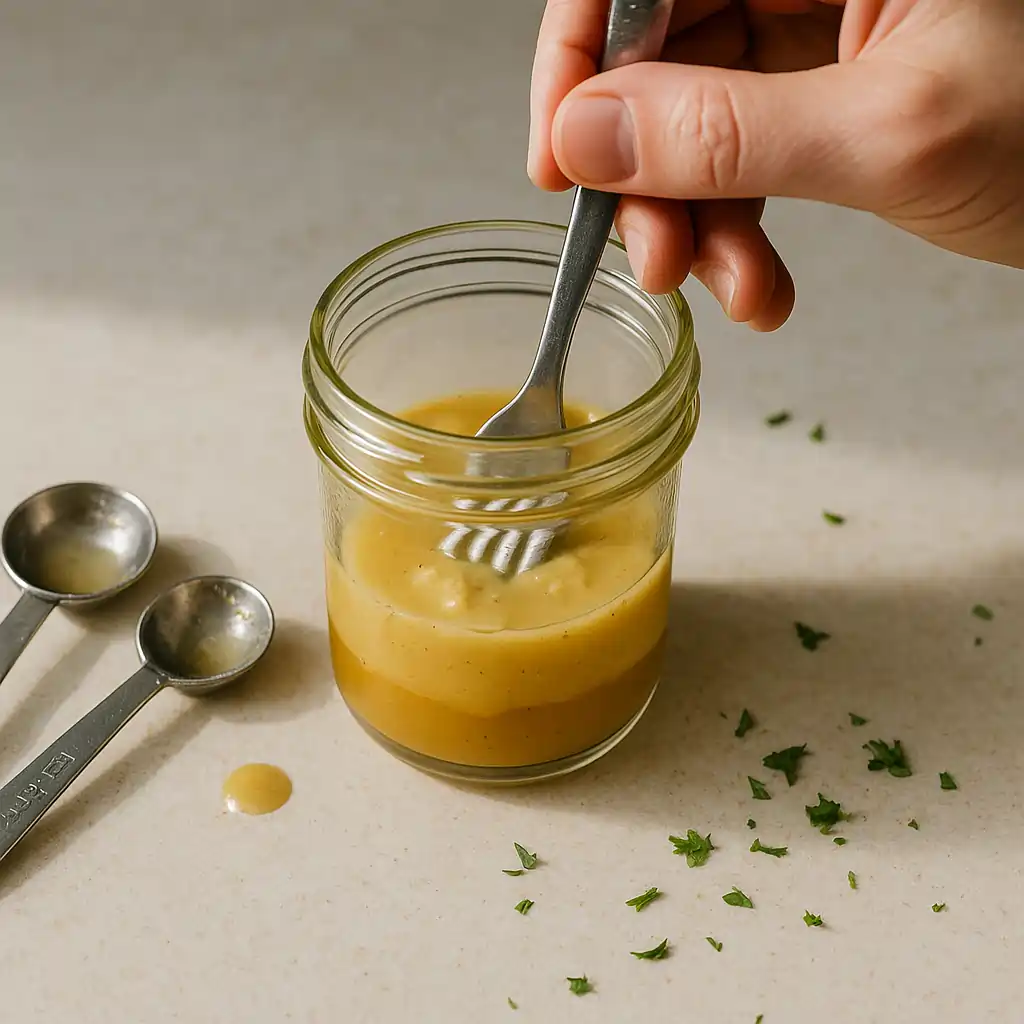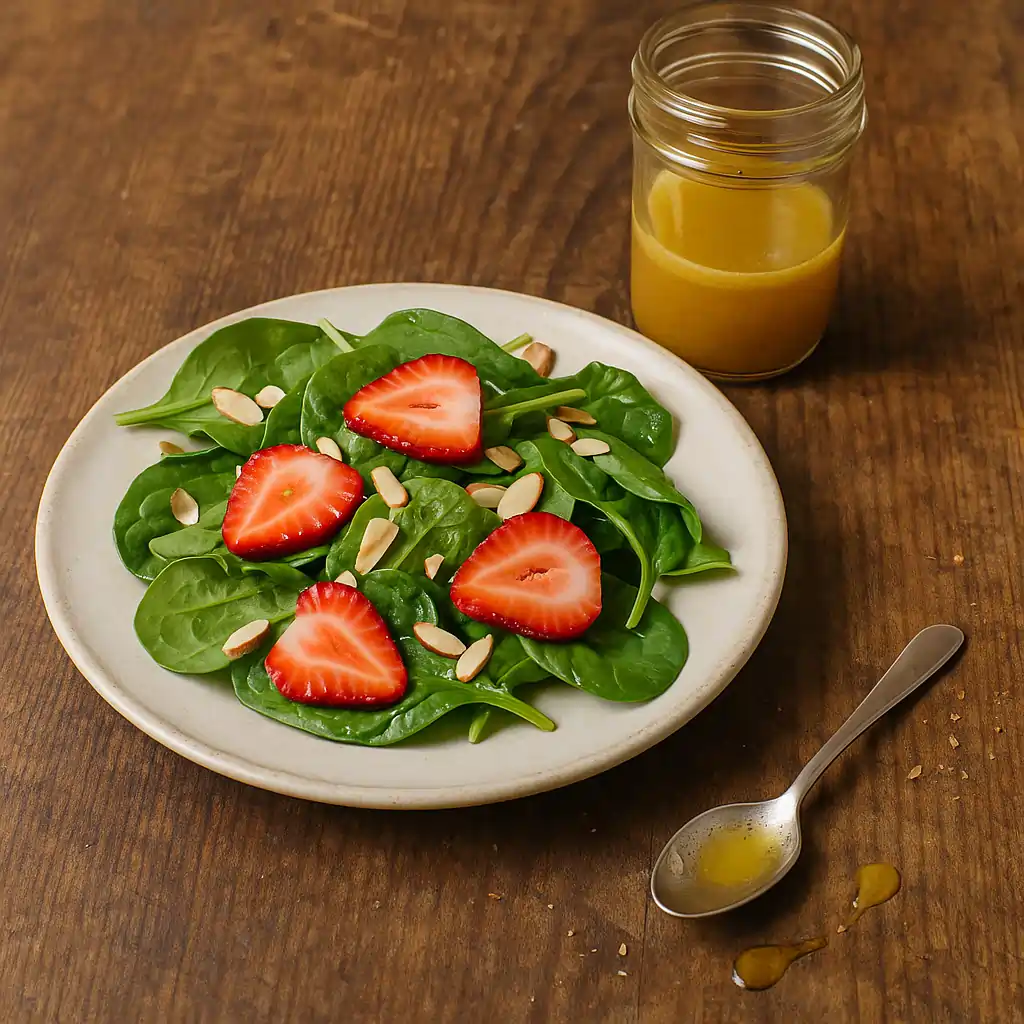I used to think the only fix for a sharp vinaigrette was “add more honey.” Guilty. Then I learned to balance sweet, tart, and a little heat, and boom—silky, restaurant-level honey Dijon salad dressing in five minutes flat. You’ll get the classic plus a honey-balsamic riff that tastes fancy with zero fuss.

Table of Contents
Table of Contents
Balancing sweet, tart, and heat
Honey is the roundness, not the whole song. It softens edges and adds body, but too much turns the bowl into dessert, so I start small and build. Dijon is my glue; it emulsifies and gives a gentle bite that keeps sweetness in check.
Acid is the steering wheel. Apple cider vinegar is friendly and bright, while lemon adds sparkle on the finish, so I often use both. If things taste sleepy, a tiny squeeze of lemon at the end wakes the whole jar up without cranking sweetness.
Heat is optional but magic. A pinch of black pepper or a few red pepper flakes makes the honey read more “caramelized” than sugary. I once dumped in cayenne like a dare and, yeah, chaos—one pinch is plenty, hero.
My rule of thumb: start at a 3:1 vibe (oil to acid), then lighten with water so it clings instead of gloops. Taste on a leaf, not a spoon. Spoons lie; greens tell the truth.
Base recipe (classic honey mustard vinaigrette)

In a small jar, add:
- 3 Tbsp apple cider vinegar
- 1 Tbsp fresh lemon juice
- 2 tsp Dijon mustard
- 1–1½ Tbsp honey (start at 1 Tbsp, adjust to taste)
- 2 Tbsp cold water
- Pinch fine salt and black pepper
Shake to dissolve, then add 6 Tbsp extra-virgin olive oil. Seal and shake hard for 20 seconds until glossy and slightly cloudy. Taste on a lettuce leaf.
If it’s too sharp, add 1 more Tbsp water before more oil. If it’s too sweet, squeeze a little more lemon or add a ½ tsp Dijon to tighten the edges. If it feels flat, a pinch of salt or a grind of pepper usually snaps it to attention.
Texture note: water is not cheating. It lightens calories and helps the dressing cling to watery veggies. I learned that after drowning a delicate butter lettuce and wishing I could un-wet leaves—can’t do it, friend.
Optional add-ins
- 1 tsp very finely minced shallot (macerate in vinegar 5 minutes first)
- A micro-grate of lemon zest for perfume
- A pinch red pepper flakes for warm heat
- ½ tsp nutritional yeast for subtle “savory” depth
Honey Dijon Salad Dressing
Equipment
- small jar with lid
- measuring spoons
- citrus juicer
- microplane zester (optional)
- small whisk or fork (if not shaking)
Ingredients
- 3 tbsp apple cider vinegar
- 1 tbsp fresh lemon juice
- 2 tsp Dijon mustard
- 1.5 tbsp honey (start with 1 tbsp, adjust to taste)
- 2 tbsp cold water
- 1 pinch fine salt
- 1 pinch black pepper
- 6 tbsp extra-virgin olive oil
Instructions
- In a small jar, add apple cider vinegar, lemon juice, Dijon mustard, honey, water, salt, and pepper. Shake or stir to dissolve the honey completely.
- Add the olive oil to the jar, seal, and shake vigorously for 20 seconds until glossy and slightly thickened. Taste on a lettuce leaf, not a spoon.
- Optional: Add finely minced shallot, lemon zest, red pepper flakes, or nutritional yeast for extra depth. Let sit 5 minutes if using shallots.
- Store in the fridge for 1–2 weeks if using dried ingredients only. If using fresh shallots or herbs, consume within 3–5 days. Shake before each use.
Notes
- Use apple cider vinegar and lemon juice together for a bright, friendly acidity.
- Add water to lighten texture and help it cling to greens.
- Optional add-ins like shallot, red pepper flakes, or nutritional yeast add depth.
- For a cozy variation, try the honey-balsamic riff with spinach, fruit, or roasted veggies.
Honey-balsamic variation (silky, cozy, date-night easy)
Balsamic brings built-in sweetness and a richer vibe. It’s the move for spinach salads with strawberries, nuts, and cheese, or roasted veg bowls.
In a jar, combine:
- 3 Tbsp balsamic vinegar
- 1 tsp Dijon mustard
- 1–2 tsp honey (start at 1)
- 2 Tbsp water
- Pinch salt + pepper
Shake, then add 4–5 Tbsp extra-virgin olive oil (balsamic is softer, so you can run a slightly tighter ratio). Shake until glossy. Taste on a leaf.
Too sweet? Add 1 tsp apple cider vinegar or lemon to sharpen. Too thick? Water by the tablespoon until it pours like light cream. Want a steakhouse moment? Finish with a tiny crack of pepper at the table and pretend you have a server named Marco.
Pairings (bitter greens, grain bowls, and more)

Bitter greens: Arugula, radicchio, and baby kale love honey Dijon because the sweet-tart balance tamps down bitterness. I toss light, add shaved Parmesan or pecorino, and it eats like a side you didn’t have to beg people to try.
Crunchy chopped salads: Romaine, cukes, cherry tomatoes, and roasted chickpeas absolutely slap with the classic version. A few sunflower seeds on top and suddenly lunch feels intentional, not “I found things in the fridge.”
Grain bowls: Warm farro or quinoa drinks up the dressing without getting soggy. I add roasted sweet potatoes, brussels, or broccoli, then drizzle and toss while the grains are still warm. That honey-balsamic version is killer here—cozy but still bright.
Fruit + nut combos: Spinach + sliced strawberries + toasted almonds is the honey-balsamic poster child. For autumn vibes, do radicchio + thin apple + walnuts + blue cheese with the classic base, extra pepper. It shocks people in a good way.
Contrast play: Want sweet-heat? Pair a drizzle of this with a few dots of /chipotle-salad-dressing/ on tacos or burrito bowls. Want something zest-forward? Serve the classic alongside /mexican-salad-dressing/ and let them tag-team the plate.
Storage
Vinaigrettes keep well 1–2 weeks in the fridge when they’re just oil, vinegar, honey, and dried spices. If you used fresh shallot or herbs, aim to finish in 3–5 days for peak flavor. I write the date on the lid because future-me forgets.
Olive oil can firm up in the cold. I set the jar out for 10 minutes while I chop, or run it under lukewarm water, then shake like I mean it. Separation isn’t failure; it’s physics—Dijon and a good shake put it right back together.
If anything smells off, looks fizzy, or wears a fuzzy hat, it’s gone. New jar, two minutes, no drama. I learned that the hard way after trying to rescue a science project. Not worth it.
FAQs
What is honey Dijon salad dressing made of?
Olive oil, Dijon mustard, honey, and vinegar (often apple cider), plus water, salt, and pepper to balance.
What’s the best oil-to-acid ratio?
Start near 3:1 and lighten with 1–3 Tbsp water so it clings without feeling heavy.
Can I make it sugar-free?
Skip the honey and follow the balance tricks in /sugar-free-salad-dressing/—use water, zest, and herbs for roundness.
For more ratio smarts and storage tips, my Guide to Salad Dressing is your north star. Want a bright ACV spin that swaps right into this method? Hop to Apple Cider Vinegar Salad Dressing (5 Minutes).
Conclusion
Honey Dijon hits that sweet-spot trifecta: fast, silky, and balanced. Learn the base, keep water in your pocket, and tweak with lemon and pepper instead of dumping in more honey. When you want cozy, switch to the honey-balsamic version and watch even simple salads feel special.
Tell me how you riffed it—extra Dijon, different vinegars, wild pairings. Share your tweaks in the comments so we can all steal them for dinner tonight. And if a batch goes sideways, no panic: water, lemon, shake, victory.
